
The financial sector stands at the point of major transformation. AI adoption in finance has surged by 72% in just the past two years. Financial institutions worldwide are racing to implement intelligent solutions. The stakes couldn’t be higher in this competitive landscape.
Table of Content
Another addition to this the integration of Artificial Intelligence (AI) agents. These intelligent systems are not just augmenting traditional financial processes but are also pioneering new methodologies that enhance efficiency, accuracy, and customer satisfaction.

Do you know the global AI agents market is projected to grow from $7.38 billion in 2025 to $47.1 billion by 2030? It’s reflecting a compound annual growth rate (CAGR) of 44.8%. This rapid growth underscores the significant impact AI agents are having across various industries, particularly in finance.
Think of them as digital financial experts working round the clock. They analyze data, make decisions, and execute transactions autonomously. These intelligent systems are reshaping how financial services operate. They utilize machine learning, natural language processing, and other AI methodologies to operate effectively.
. 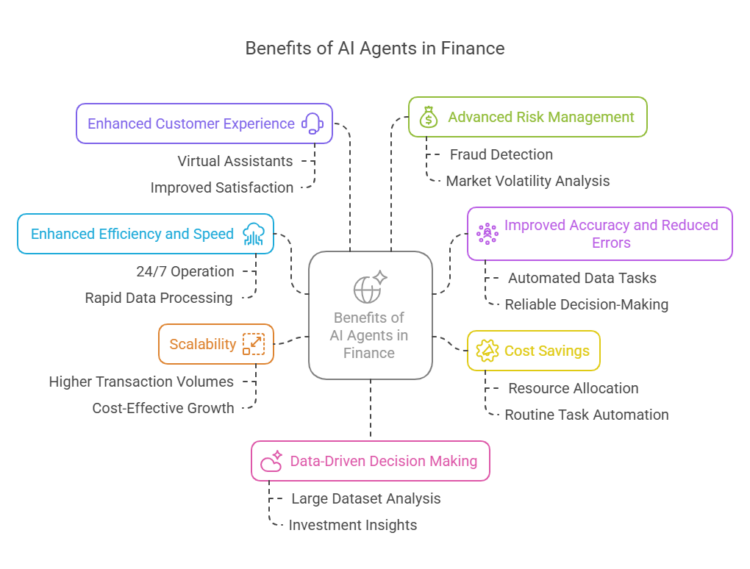
Banks investing in AI see a 3.5x higher revenue growth than non-adopters. This statistic alone highlights the revolutionary potential of AI agents. Financial leaders can no longer ignore this technological shift.
Let’s explore how AI agents are transforming financial services. Check on their capabilities, applications, and implementation costs. You’ll discover why these intelligent systems represent the future of finance
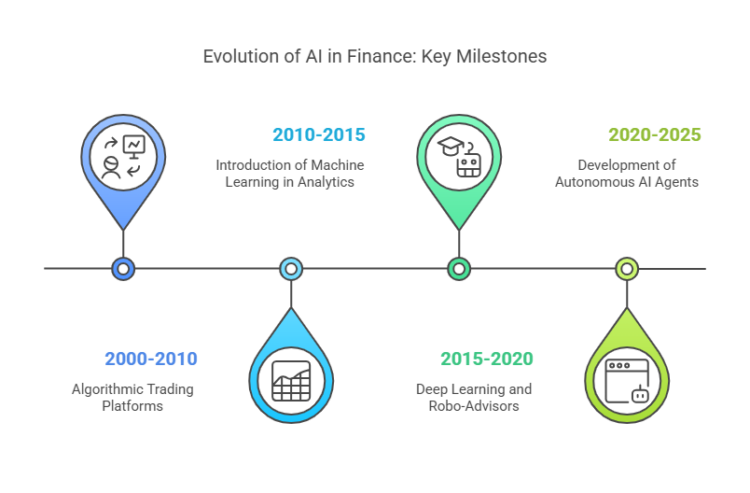
The journey of AI in finance is nothing new. It spans several years as of now. The 2000s witnessed the rise of algorithmic trading platforms. These systems could execute trades at superhuman speeds. Yet they lacked the adaptability of modern AI agents.
By 2010, machine learning began transforming financial analytics capabilities. Systems could now identify patterns humans might miss. This period marked the shift from rule-based to learning-based systems.
The fintech revolution of the 2010s accelerated AI adoption dramatically. Traditional institutions faced competition from agile, tech-driven startups. This competitive pressure fueled investment in advanced AI capabilities.
Today’s AI agents represent the peak of this evolutionary journey. They combine multiple AI technologies into cohesive intelligent systems. The modern finance agent can reason, learn, and adapt autonomously.
Financial services face extraordinary disruption through AI agents. Traditional financial processes often required days to complete. AI agents can perform the same tasks in seconds or minutes. This efficiency transforms customer expectations and operational capabilities.
Consider the loan approval process transformation. Previously, loan approval required extensive paperwork and human review. Applicants waited weeks for decisions based on limited criteria. The process frustrated customers and strained bank resources.

AI agents have revolutionized this experience entirely. They analyze hundreds of data points in real-time for each application. Decisions arrive within minutes rather than weeks. Both accuracy and customer satisfaction improve dramatically.
Similar transformations occur across the financial landscape. Customer service, fraud detection, and investment management all benefit. AI agents deliver consistency and scalability impossible with human-only teams.
Financial institutions report 25-50% cost reductions in transformed processes. Simultaneously, they experience improved accuracy and customer satisfaction. This combination makes AI implementation an increasingly essential strategy.
AI agents bring powerful capabilities to financial operations.
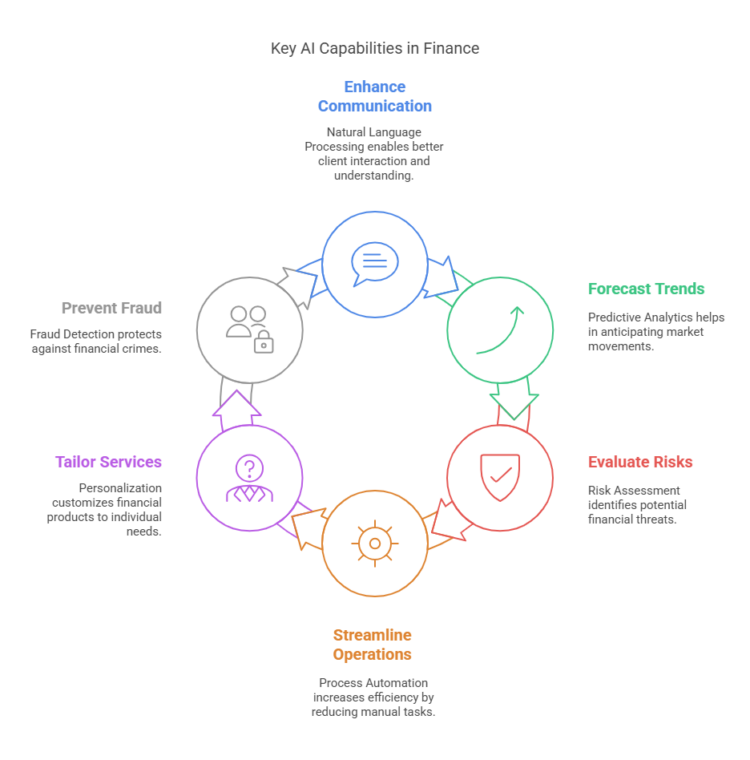
These agents understand and generate human language naturally. They can interpret customer queries regardless of phrasing. This capability enables human-like customer interactions at scale.
Chatbots powered by advanced NLP handle 85% of customer inquiries. They understand context, sentiment, and intent in customer communications. The result is faster resolutions and increased satisfaction.
Financial markets generate vast amounts of data daily. AI agents excel at identifying patterns within this data chaos. They can predict market trends with remarkable accuracy.
These predictions guide investment strategies and risk management. AI-powered forecasting reduces losses and identifies opportunities. Human analysts gain powerful tools to enhance their decision-making.
Credit risk assessment has transformed through AI capabilities. Agents analyze thousands of variables beyond traditional credit scores. They can identify good risks among applicants traditional systems reject.
Banks using AI for risk assessment report 10-15% fewer defaults. They simultaneously increase approval rates among historically underserved groups. This represents both business improvement and greater financial inclusion.
Routine financial tasks consume significant human resources. AI agents can handle these processes with greater efficiency. They excel at data entry, reconciliation, and compliance documentation.
Automation reduces errors by eliminating human fatigue factors. It also frees skilled professionals for higher-value activities. The financial workforce becomes more focused on strategy and relationships.
Each customer has unique financial needs and behaviors. AI agents analyze individual patterns to deliver personalized service. They recommend relevant products and provide timely advice.
Personalization increases engagement and product adoption rates. Customers feel understood rather than treated generically. This strengthens institutional relationships and reduces attrition.
Financial institutions deploy AI agents across diverse functions.
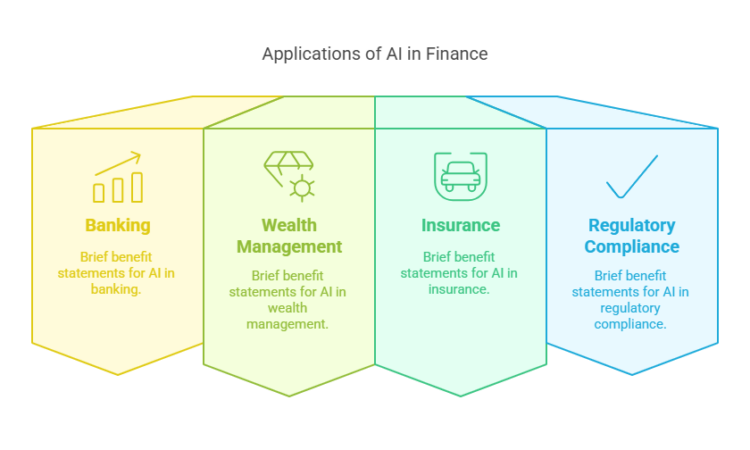
Robo-advisors represent one of the most visible AI applications. These agents create personalized investment portfolios automatically. They continuously rebalance assets based on market conditions.
Traditional wealth management required substantial minimum investments. AI-powered alternatives democratize access with lower barriers. Millions now receive professional-grade advice previously unavailable.
A leading robo-advisor platform reports managing over $20 billion. Their average client pays 0.25% in fees versus 1-2% traditionally. This combination of accessibility and value drives rapid adoption.
The insurance sector benefits enormously from AI agents. They accelerate claims processing while reducing fraud. Both insurers and customers win through improved experiences.
AI agents can assess property damage through smartphone photos. They determine claim validity and estimate costs instantly. What once took weeks now resolves in minutes.
One major insurer reduced claims processing time by 90%. They simultaneously increased fraud detection by 30%. These improvements translate to billions in savings and higher customer satisfaction.
Retail banking has embraced AI agents for customer engagement. They provide 24/7 service across multiple channels. Customers receive consistent experiences regardless of when or how they connect.
These agents handle everything from balance inquiries to dispute resolution. They can authenticate users through biometrics and behavioral patterns. Security improves alongside convenience.
Studies show 70% of banking customers now prefer digital channels. AI agents make these channels more responsive and helpful. The result is higher engagement and loyalty among valuable demographics.
Financial regulations grow increasingly complex globally. AI agents help institutions navigate this challenging landscape. They monitor transactions and flag potential compliance issues.
These systems continuously update as regulations change. They ensure documentation meets current requirements. Compliance officers receive alerts about potential violations before they occur.
Financial institutions report 40% reductions in compliance costs. They simultaneously experience fewer regulatory penalties. This efficiency allows significant resource reallocation.
Implementing AI agents requires strategic investment.
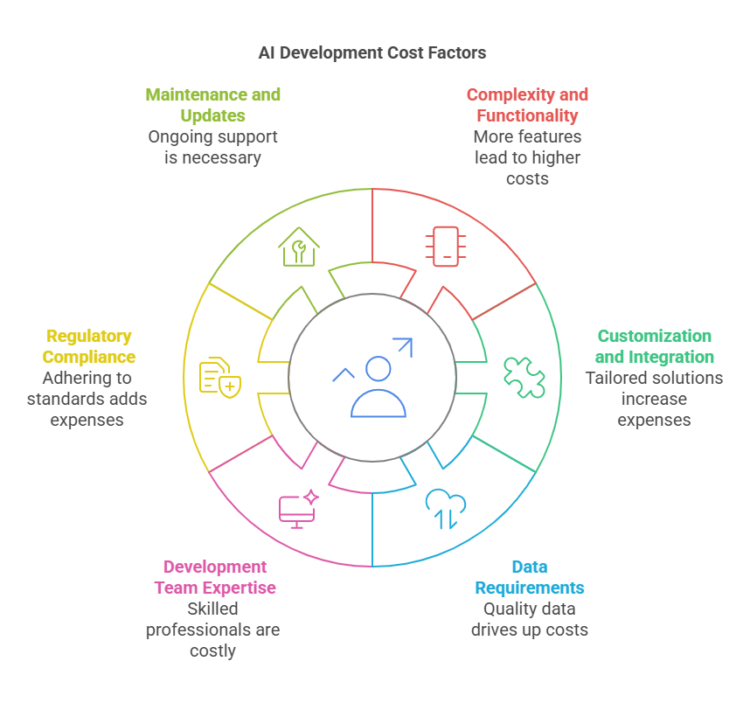
Custom AI agent development typically ranges from $75,000 to $500,000. This variation depends on complexity and capabilities required. Simple chatbots cost less than comprehensive financial assistants.
Development involves several specialized roles. Data scientists, AI engineers, and domain experts must collaborate. These skilled professionals command premium compensation packages.
Open-source frameworks can reduce initial development costs. However, customization for financial applications remains essential. Regulatory requirements necessitate specialized development approaches.
High-quality data forms the foundation of effective AI agents. Financial institutions must clean and structure their existing information. This process often consumes 60-70% of project budgets.
Data preparation includes:
Many institutions underestimate this preparation phase. They encounter unexpected costs and delays as a result. Proper planning for data preparation proves essential for success.
Financial systems often include legacy technologies. Integrating AI agents with these systems presents challenges. Custom connection points and security measures increase costs.
API development enables communication between systems. These interfaces must meet strict financial security standards. Regulatory requirements add additional integration complexity.
Integration typically represents 15-25% of total implementation costs. This percentage increases with older core banking systems. Cloud-based institutions experience lower integration expenses.
AI agents require continuous monitoring and improvement. Models must be retrained as financial conditions change. Security updates remain essential throughout the agent’s lifecycle.
Annual maintenance typically costs 20-30% of initial development. This includes cloud computing resources and specialized personnel. Institutions must budget for these recurring expenses.
The total cost of ownership extends beyond initial deployment. Financial leaders should plan for 3-5 years of operational expenses. This comprehensive approach prevents budget surprises.
Financial institutions typically achieve ROI within 12-24 months. Cost reductions and increased revenue contribute to this return. Process efficiency represents the most immediate benefit.
Customer acquisition costs decrease by 20-30% with effective AI implementation. Retention rates simultaneously improve through enhanced experiences. These factors accelerate ROI achievement.
Institutions should establish clear metrics before implementation. Measuring the right factors ensures accurate ROI assessment. This data-driven approach justifies continued investment.
The financial AI landscape continues evolving rapidly.
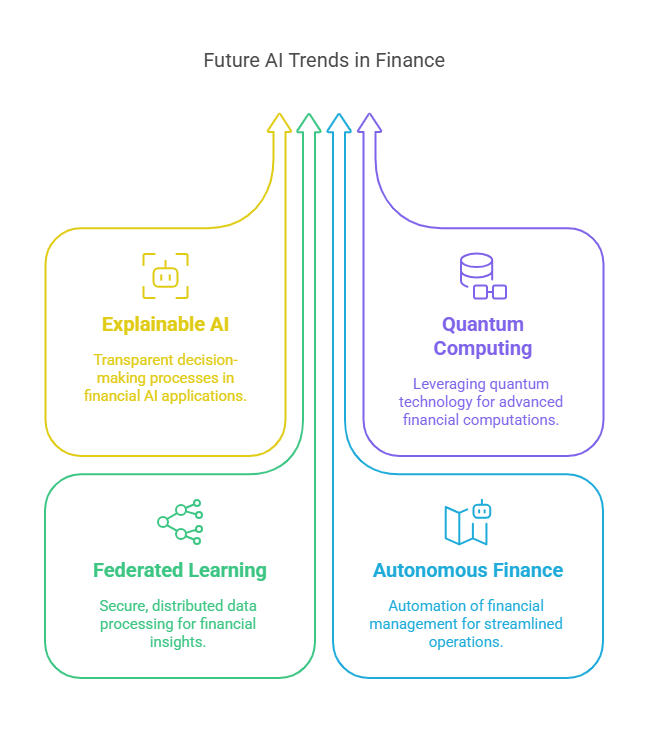
Tomorrow’s financial AI agents will provide clear reasoning. They’ll explain decisions in terms humans understand. This transparency builds trust and meets regulatory requirements.
Emerging XAI techniques visualize decision pathways clearly. They enable verification of AI reasoning processes. Regulatory pressure will accelerate adoption of these approaches.
Financial institutions should prioritize explainability now. This capability will become a competitive requirement soon. Early adopters gain advantage in regulatory preparation.
Quantum computing promises to revolutionize financial modeling. AI agents leveraging quantum algorithms will achieve unprecedented accuracy. Risk assessment and market prediction will transform.
Early quantum AI experiments show promising results. They solve complex optimization problems traditional systems cannot. Financial institutions should monitor this emerging capability.
Organizations should identify quantum-ready use cases now. Building necessary expertise requires time and investment. The competitive advantage will be substantial for prepared institutions.
Data privacy concerns continue growing globally. Federated learning enables AI training without centralizing sensitive data. This approach perfectly suits financial applications.
Models learn from data that never leaves secure environments. Multiple institutions can collaborate without sharing confidential information. Regulatory compliance becomes simpler.
Financial consortiums have begun exploring this approach. They recognize the competitive advantage of broader training data. This trend will accelerate as privacy regulations tighten.
The ultimate evolution will be fully autonomous financial systems. These will manage routine transactions without human intervention. Customers will establish parameters rather than execute actions.
Early versions already handle automatic savings and bill payments. Future iterations will manage investment portfolios and financial planning. Human advisors will focus on complex emotional decisions.
Leading institutions have begun developing autonomous finance platforms. They recognize this represents the future of retail banking. Early market position will determine long-term winners.
Financial institutions can begin their AI journey strategically.
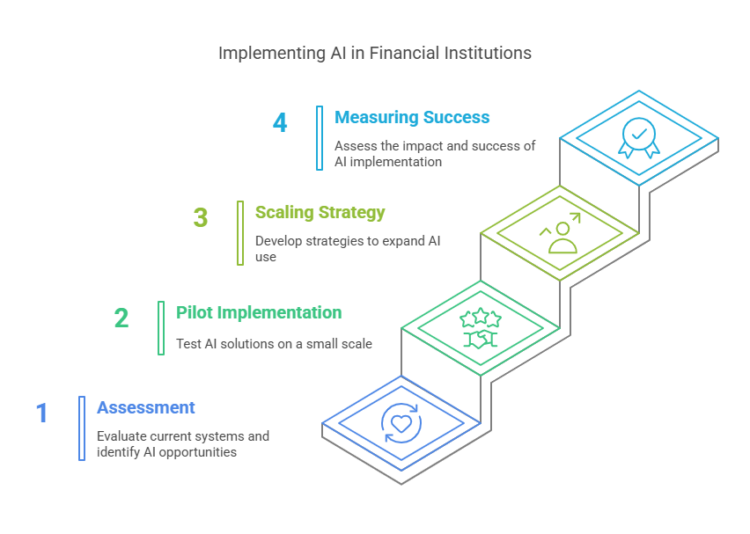
Start by identifying high-impact, achievable use cases. Look for processes with clear metrics and substantial volume. Customer service and document processing often represent good starting points.
Evaluate your data readiness before proceeding. Determine what preparation work must precede implementation. This assessment prevents costly surprises later.
Form a cross-functional team including business and technical leaders. Ensure representation from compliance and customer experience. This diverse perspective improves planning quality.
Begin with a limited-scope pilot project. Choose a non-critical process to reduce risk. Set clear success metrics before beginning implementation.
Consider partnering with established AI vendors initially. This approach reduces technical risk while building internal expertise. Knowledge transfer should be an explicit partnership goal.
Communicate transparently with affected employees throughout the process. Address concerns and highlight how AI will enhance rather than replace their work. Cultural acceptance determines success.
Document lessons learned during the pilot phase carefully. Apply these insights to planning larger implementations. Prioritize projects based on business impact and complexity.
Develop a multi-year technology roadmap for broader implementation. Include required infrastructure upgrades and data preparation. Secure executive sponsorship for this long-term plan.
Create centers of excellence to maintain momentum. These specialized teams share knowledge across the organization. They become internal consultants for subsequent projects.
Establish comprehensive metrics beyond simple cost reduction. Include customer satisfaction, employee experience, and risk reduction. These broader measures demonstrate full business impact.
Implement continuous monitoring and improvement processes. AI systems require ongoing refinement to maintain effectiveness. Build this expectation into operational budgets.
Share successes broadly throughout the organization. Celebrate teams that effectively leverage AI capabilities. This recognition accelerates adoption and innovation.
Simply– AI agents represent the future of financial services. The institutions embracing this technology gain significant advantages. They deliver superior customer experiences while reducing costs. Operational efficiency and accuracy improve simultaneously.
Where does your organization stand on this journey? The time for exploration has ended. Implementation represents the path forward for competitive financial institutions. Integrating AI agents is crucial for enhancing efficiency, security, and customer satisfaction. Here when Code Brew Labs comes into play.
We specialize in developing AI agents tailored for financial services, offering solutions that streamline operations and drive innovation.
By choosing Code Brew Labs, your financial organization can leverage AI technology to enhance operations, security, and customer satisfaction, ensuring a competitive edge in a dynamic market
